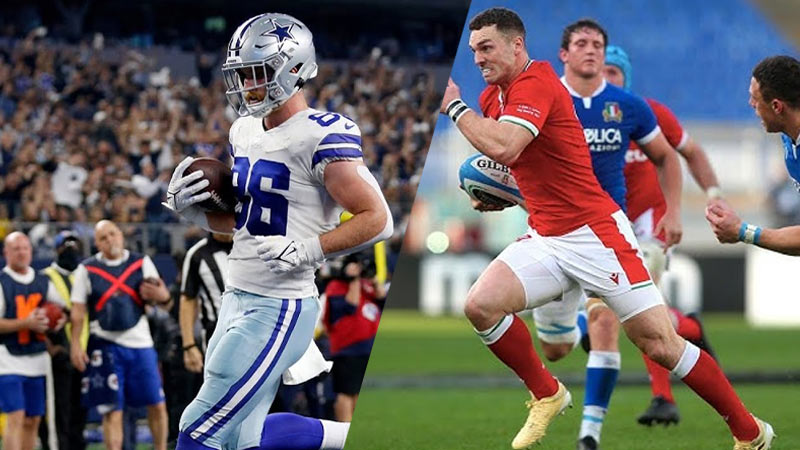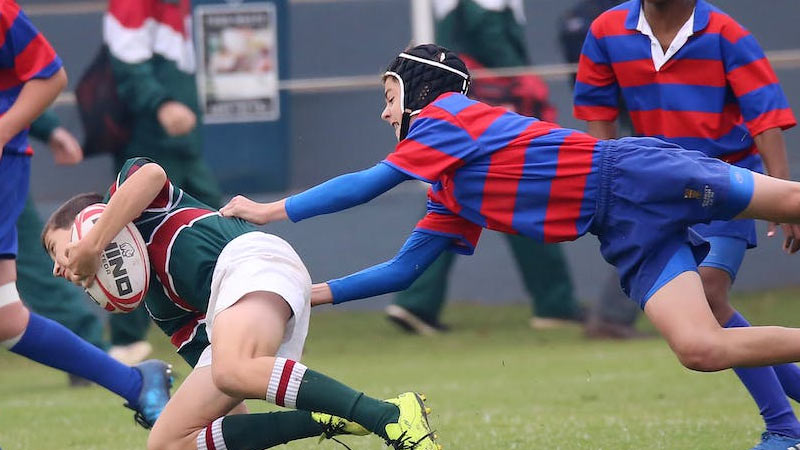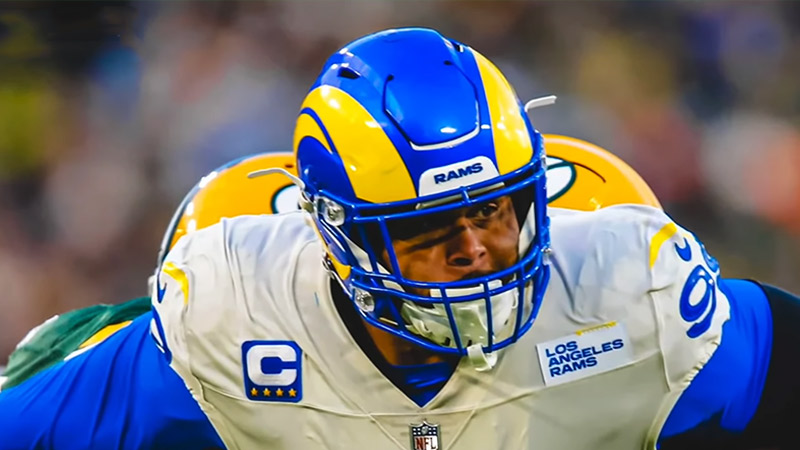In the world of contact sports, the image of athletes donning helmets is a common sight, symbolizing the paramount importance of safety amidst the physical rigors of the game.
However, an intriguing paradox unfolds when we compare two prominent contact sports, American football and rugby.
In American football, helmets are ubiquitous, an essential shield protecting players as they engage in fierce battles on the gridiron. Yet, in rugby, a sport equally renowned for its physicality, players venture onto the field without such headgear.
This striking contrast raises a fundamental question: Why do they wear helmets in American football but not in rugby? Unraveling this enigma necessitates an exploration of historical, cultural, and safety considerations that have steered the path of these two beloved sports.
Why Do They Wear Helmets in American Football but Not Rugby?
The use of helmets in American football but not in rugby can be attributed to several factors, including differences in tackling techniques, playing style, cultural tradition, and historical evolution.
Here’s a breakdown of these key factors:
Historical Evolution
American football and rugby share a common ancestry in rugby football. However, they have evolved differently over time. In the early 20th century, American football introduced helmets and other protective gear in response to growing concerns about player safety.
This marked a significant departure from the rugby tradition, which maintained a simpler and less heavily padded approach.
Tackling Rules and Techniques
American football and rugby have distinct tackling rules and techniques. In American football, players are allowed to tackle opponents anywhere on the body, including above the shoulders.
This aggressive tackling style can lead to head injuries, making helmets a vital component for reducing the risk of concussions, skull fractures, and brain damage. In contrast, rugby has stricter rules against high tackles and employs techniques that aim to minimize head contact.
Playing Style and Strategy
American football and rugby have different playing styles. American football features short, intense bursts of action and collisions, often at high speeds.
Helmets are integral in this context, as they allow players to be more aggressive and fearless during tackles, blocks, and runs.
In rugby, the game is more continuous and requires players to be agile, and mobile, and to maintain clear vision. Helmets could restrict movement and hinder peripheral vision, which is crucial in the flowing nature of rugby.
Cultural and Traditional Factors

Culture and tradition play a significant role in why helmets are worn in American football and not in rugby. American football has embraced the use of helmets as an essential part of its identity and aesthetics.
Helmets have become a symbol of the sport’s toughness and have been integrated into the culture. In rugby, there is a strong emphasis on tradition and maintaining the sport’s historical integrity.
Rugby players often take pride in their resilience and toughness and view helmets as unnecessary or even antithetical to the sport’s spirit.
What Are the Safety Implications of Headgear in American Football and Rugby?
The safety implications of headgear in American football and rugby are multi-faceted and critical to consider. While headgear offers protection, it also brings its own set of safety implications:
Head Injury Mitigation
Headgear in American football can mitigate head injuries, reducing the risk of concussions, skull fractures, and brain injuries. In rugby, the absence of headgear emphasizes safe tackling techniques, potentially lowering the risk of head injuries.
False Sense of Security
Helmets in American football can sometimes lead to a false sense of security, encouraging riskier plays and head-on collisions.
In rugby, players must rely on proper technique rather than equipment for tackling, reducing the chance of injury but necessitating greater awareness.
Agility and Mobility
The absence of headgear in rugby enhances player agility and mobility, contributing to a more dynamic playing style. However, this could expose players to head injuries due to the lack of protection.
Fear of Injury
In rugby, the fear of head injury may influence players to engage more cautiously in physical contact, potentially reducing the intensity of the game.
In American football, the protection offered by helmets may encourage more aggressive play.
Cultural and Historical Significance
In both sports, the presence or absence of headgear reflects the cultural and historical values of the game. However, this can sometimes prioritize tradition over player safety, particularly in rugby.
Player Confidence and Performance
Helmets in American football boost player confidence, enabling them to engage in more aggressive tackles. In rugby, proper tackling technique is paramount, and headgear is absent, potentially influencing players’ aggressiveness.
Impact on Visibility
Facemasks and headgear can impact player vision in American football, but they also protect against facial injuries. In rugby, visibility remains clear but at the cost of facial protection.
Are There Any Helmet-Like Safety Gear Used in Rugby, Even if Not Full Helmets?

Yes, in rugby, players have the option to wear a type of headgear known as “scrum caps” or “head guards.” While not full helmets, these protective caps are designed to reduce the risk of cuts, abrasions, and minor head injuries during close-contact scrums and rucks.
They consist of padded materials and offer a lightweight and comfortable alternative to full helmets. However, they do not provide the same level of impact protection as American football helmets.
Rugby places a stronger emphasis on proper tackling techniques and minimizing head contact through strict rules, making these headgear options more about reducing superficial injuries than preventing concussions.
How Do Other Protective Gear and Padding Differ Between American Football and Rugby?
The protective gear and padding used in American football and rugby vary significantly due to the distinct nature of these sports.
Here’s a comparison of how they differ:
American Football
- Helmets: American football players wear advanced helmets with a hard outer shell and cushioning materials designed to minimize head injuries, including concussions. Face masks are attached to helmets to protect the face from impact and facial injuries.
- Shoulder Pads: American football players wear substantial shoulder pads that provide protection to the shoulders and upper body. These pads are designed to absorb and distribute the force of collisions, reducing the risk of shoulder injuries and chest contusions.
- Pads and Padding: Players also wear padded pants, thigh pads, knee pads, and hip pads. These additional pads provide protection for the lower body, reducing the risk of abrasions, contusions, and other injuries during tackles and falls.
- Protective Gear: American football players wear additional protective gear, such as rib protectors, flak jackets, and padded gloves to safeguard against injuries to the ribs, torso, and hands.
Rugby
- Scrum Caps: In rugby, players have the option to wear scrum caps, also known as headgear, which primarily protect against superficial head injuries, such as cuts and abrasions. These caps do not provide the same level of impact protection as American football helmets, particularly concerning concussions.
- Mouthguards: Rugby players are required to wear mouthguards to protect their teeth and jaws during play. Mouthguards also help reduce the risk of concussions by stabilizing the jaw and cushioning impacts to the head.
- Jerseys and Shorts: Rugby players wear jerseys and shorts without extensive padding. The attire is designed to be lightweight and flexible, allowing for ease of movement and agility on the field.
- Boots: Both American football and rugby players wear specialized footwear, but the type and design of the boots differ based on the requirements of the respective sport. Rugby boots typically have molded or screw-in studs for grip on soft playing surfaces.
FAQs
What do helmets symbolize in American football and rugby?
In American football, helmets symbolize safety and aggression, while their absence in rugby signifies tradition, skill, and inclusivity, reflecting the core values of each sport.
Can the use of helmets in American football be a potential model for improving safety in other contact sports?
The use of helmets in American football could serve as a model for enhancing safety in other contact sports, provided sport-specific considerations are taken into account.
Are there discussions in rugby about introducing helmets for safety purposes?
While discussions on rugby safety are ongoing, there have been limited formal considerations for introducing helmets due to the sport’s emphasis on tackling techniques and tradition.
Can rugby players choose to wear helmets for extra protection?
Yes, rugby players can choose to wear headgear or scrum caps for additional protection, though it’s not mandatory. These accessories provide some protection against cuts and abrasions.
How do helmets impact player performance in American football and rugby?
In American football, helmets provide confidence and protection but may restrict agility. In rugby, their absence fosters agility and safer tackling techniques, emphasizing player mobility.
To Recap
The enigma of helmets in American football and their absence in rugby unveils a rich tapestry of historical, cultural, and safety-driven complexities. The divergence in headgear choice symbolizes the distinct identities and philosophies of these sports.
American football’s ubiquitous helmets, born of safety concerns and advanced technology, are both emblematic of the sport’s commitment to player protection and a tool to mitigate the devastating impact of concussions.
On the other hand, rugby, deeply rooted in tradition and a minimalistic ethos, opts for alternative approaches to safeguard its athletes. Here, the scrum cap serves as a compromise between tradition and safety, offering superficial protection while preserving the sport’s core essence.
This intriguing contrast showcases the multi-faceted nature of sports, where history, culture, and safety interweave to shape the identity and practices of these beloved games.







